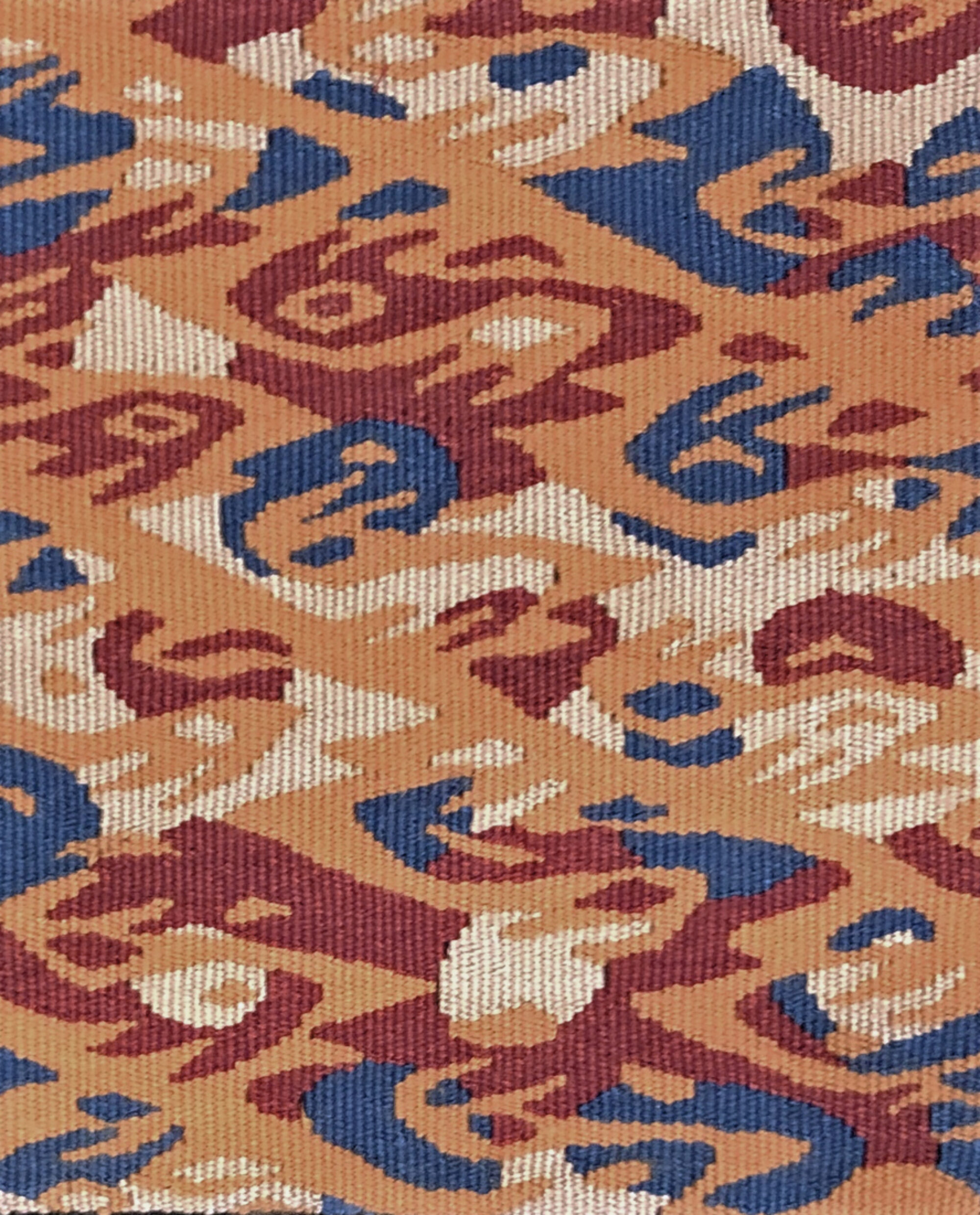This article was first published in the Fall 1996 issue of the International Tapestry Journal.
Although the use of text in contemporary imagery may seem novel in the light of Modernist practices, the association has earlier origins that reflect both common structure and function. Images and words stabilize and preserve our perception of reality by offering a framework according to which the amorphous and shifting complex of sensory experience may be organized and interpreted. They are representations – signs, which like the symbolic and metaphorical, derive meaning from their reference to an external reality. However, their relationship to reality is not transparent. A distance separates what is represented from the representation, and it is within this hiatus that the representation can be seen to be an interpretation, a contingent reading colored by social, political, economic and personal ideology.1 is expressed directly through content, but also through the conventions of the media. Artistic and literary conventions reflect the way in which a people come to understand their world.2 As Rudolph Arnheim has pointed out, these conventions are not stable. As cultural conditions change, so to do the organizational principles of literature and the visual arts.3
Functional similarities between images and language reflect common roots. Early hieroglyphs, or picture words, fuse the image based representation of art with the symbolic and abstracted qualities of language. Although they are formally reduced, presenting a condensation of an event, hieroglyphs make no pretension to mask their discursive nature. Unlike other forms which tend to emphasize style over content, hieroglyphs lay bare the functional relationship between word and image.
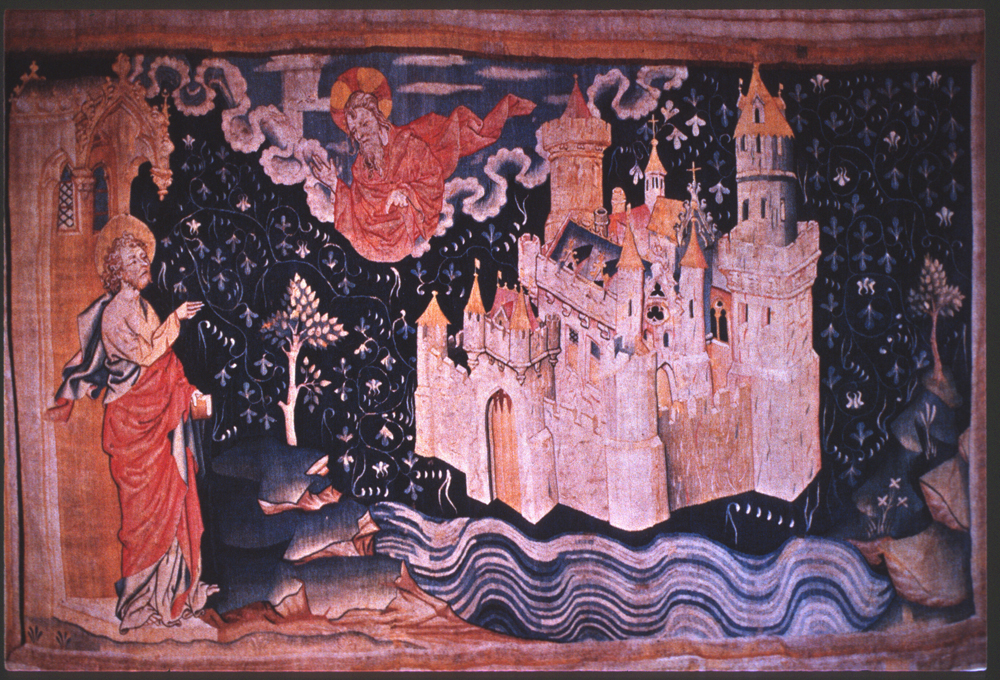
The evolution of symbolic language, which some believe to be modeled on textiles and textile processes,4 led to a differentiation in the representational jobs of images and writing, and to a change in their interrelationship. During the Middle Ages, during which tapestry developed as a mural art form, Christian attitudes colored the production of both secular and sacred imagery. In illustrating Biblical text the issue of idolatry elicited the Western church’s defense of images as didactic tools.5 Text linked the image to its Biblical source, thereby validating its function.The Apocalypse of Angers , ca. 1379, portrays the end of time as revealed to St. John. Each scene in the tapestry refers to a particular passage from Revelations, and although now missing, text is thought to have accompanied the images. Text bound to images in this way often identified characters and events, but as Alice Zriebec notes, “Rarely is the viewer asked to understand simply the story or image depicted, but rather the implications of that event or its political allusions.”6 Images present and confirm ideology and the tapestries of the Middle Ages often included text that pointed out the moral or political lesson illustrated. Thus, the weaving of The Trojan War can be seen as an historical and political statement by the Kings of France who traced their lineage, and thus their legitimacy, to the ancient world. Because these monarchs derived their authority from blood and might, an association with historically venerated and victorious ancestors was particularly appropriate.
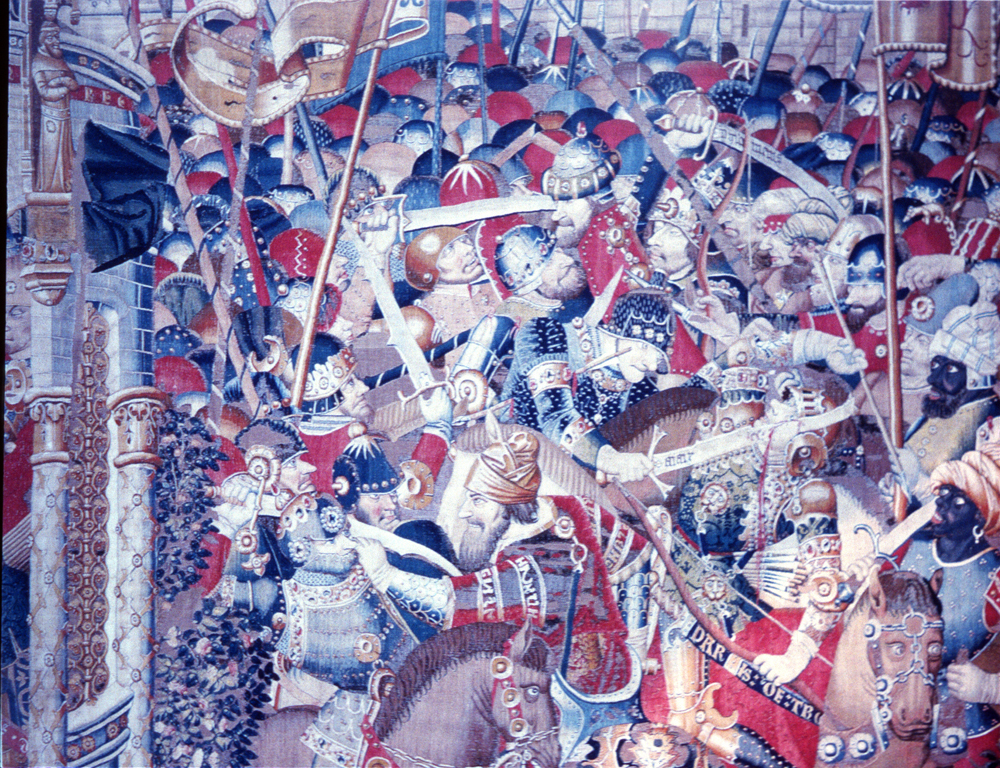
With the rise of humanism during the Renaissance, images began to reflect a new interest in humans and their life on earth. Humans came to understand themselves as agents capable of influencing their own destiny. This secular attitude is reflected in naturalistic depictions of the human form, society and the world, a style which depended on an increasing volume of descriptive information. In addition, the Renaissance development of linear perspective created a calculated distance between the viewer and the image in which the viewer was placed outside the image. The world in pictures became sufficient onto itself, and although text was still often present, it became supplementary.7
Louis XIV’s minister, Charles LeBrun, founded the French Academy in 1648. LeBrun’s motives were primarily economic and political in their challenge to the power of the guilds, but the Academy had far reaching effects on the relationship between image and text. For it was under the French Academy that history painting, with its close relationship to text, was glorified above all other genres. However, that relationship did not necessitate the direct involvement of text in images. The autonomy that images had gained during the Renaissance continued to develop as the perfection of technique and an exploration of art’s means allowed the production of highly detailed narratives which stood in for text. The Story of the King, a set of tapestries which celebrates the life of Louis XIV is an excellent example of both the ideological role of the image and its new found independence. This set of 20 tapestries was woven over 83 times during Louis’ reign and distributed throughout Europe to aggrandize the king.
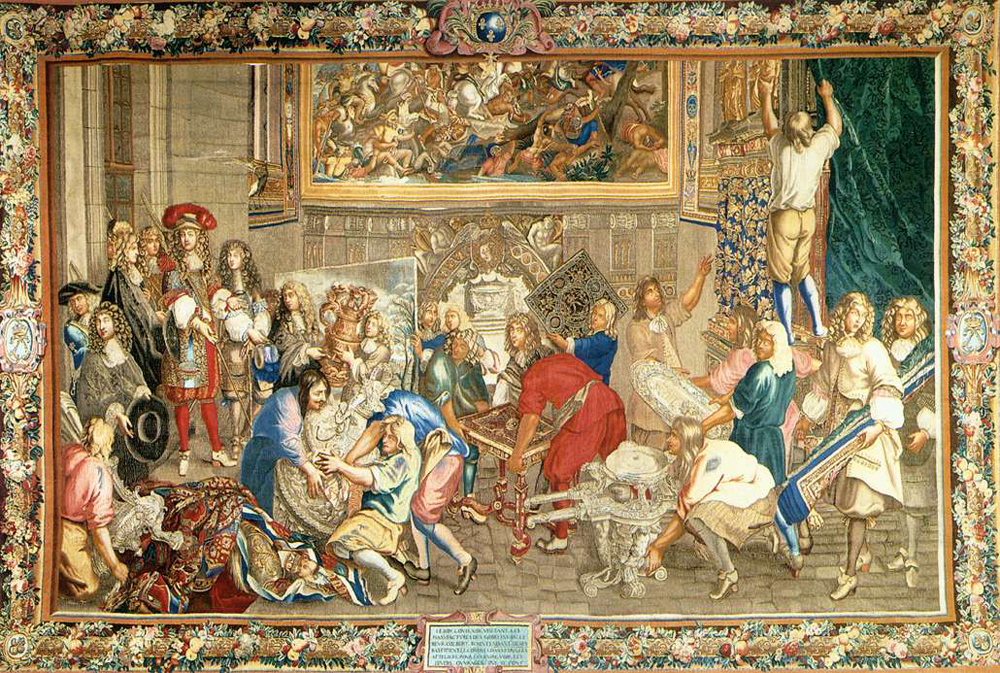
The rise of Modernism carried the autonomy of the pictorial surface to its extreme by instituting a formal break between images and language and assuming a philosophical attitude of disinterestedness that focused on pure form and aesthetics. Modernism denied the distance between the depicted and the depiction that is central to language and narrative imagery, claiming instead that pure art is an immediate expression of the artist’s psyche, a notion which finds its roots in nineteenth century Romanticism.8
This view of art as autonomous and nonreferential has been countered in the postmodernist era, which sees all art as a form of communication, a culturally coded interpretation of reality. This perspective tends to de-emphasize Romantic notions of artistic genius and psychological pathos and focus instead on the ways in which images signify, and the role of the viewer in interpreting the image. As signs operating in a discursive system, the verbal and visual tend to fuse functionally and aesthetics once again reaches out to embrace both words and images as signifying tools.9 From this perspective it is not surprising to find an increasing interest in traditional allegorical forms, which ground the present in the past and link the verbal to the visual.
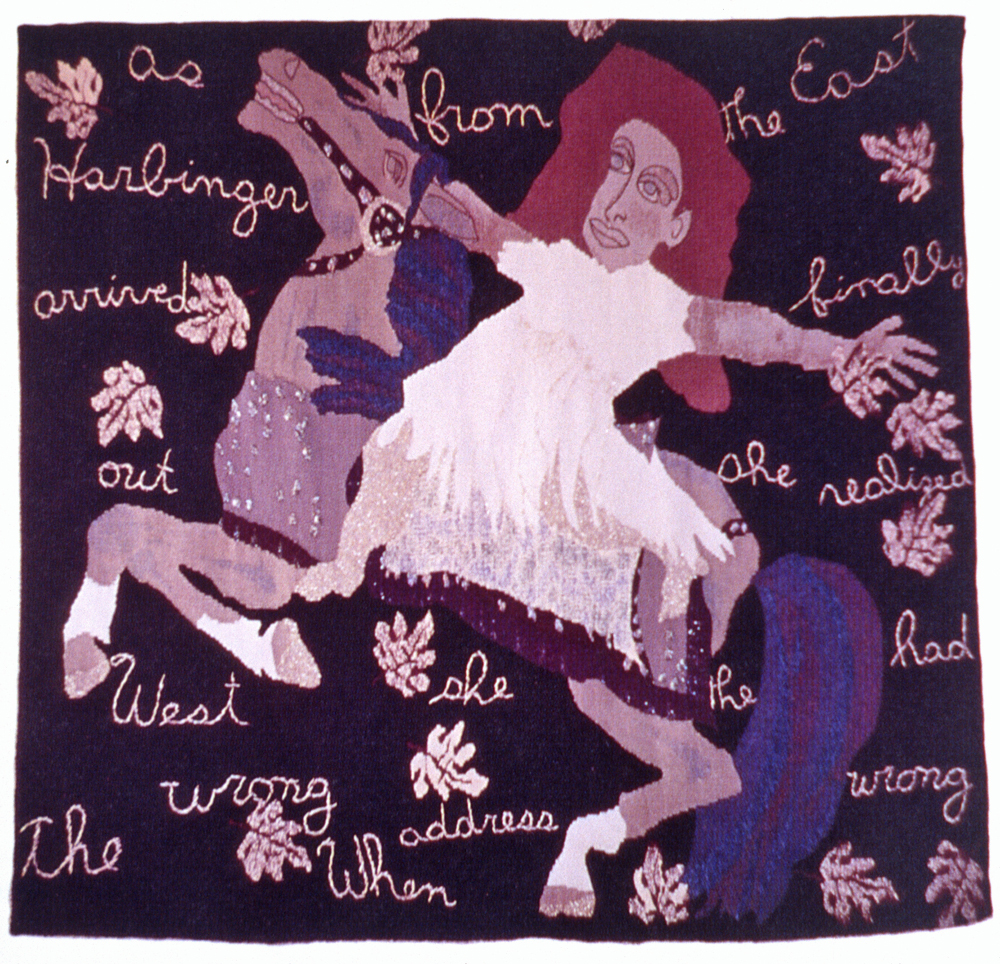
Mary Donovan’s tapestry, When the Harbinger Arrived From the East, She Realized She Had the Wrong Address, uses references to the genres of western cowboys, classical Roman equestrian statues and millefleur tapestries to reflect on progress, goals and tapestry itself. Allegory’s use of appropriation, Craig Owens points out, is a way to resurrect and save the past. It is also a way in which the present can be read through the past.10 Donovan’s interpretation of the past is humorous (is that actually a carousel horse?) and paradoxical (the hero is a woman), and the present is a used to question the myths of the past (the outcome of that great adventure was simply arriving at the wrong address). The handwritten text’s aimless circling about the surface, it’s refusal to conform to linear narrative, suggests that the mistakes of the past are bound to be repeated. The happy go lucky horse and rider seem to laugh at the pretentiousness of such archetypal myths as the progress of Western civilization, the opportunities of the western frontier and, perhaps, the glories of flat tapestry.
The contemporary use of text with images often involves fragments of words and excerpted text that can not be read or interpreted through the image alone. Words in this case do not explain the image but are one of the many pieces that coalesce into a multifaceted presentation. As representations, they are remnants of experience which have the power to suggest human presence, and which deny a purely formal approach to the work. Fragmentation and intelligibility also question Enlightenment values of reason and rationality, asserting, instead complexity and openendedness.
Donovan’s tapestry “She Never Learned to Speak in the Usual Way” is a black and white image whose text is difficult to read without the aid of the title. Its decorative pattern, isolated letters and confused frantic linear element suggest supralinguistic systems that offer additional, perhaps richer and more fundamental systems of communication. It also expresses the frustration of those who cannot access human language in a conventionally productive way. From a feminist perspective the image can be seen to express the nonspeaking, object position that women occupy within society.The fluid exchange between drawing and writing within the image merges the text and image in a way that emphasizes their communality and defies society’s distinction of the verbal and visual.
In images such as these, the role of the viewer is increasingly important; the content of the image must be engaged intellectually, excavating the meaning from fragments of images and text that defy any singular reading. Their perceptual tactics reflect our direct experience of the world as a collage of shifting impressions, requiring the observer to interpret and arrange the chaos and confusion in some way that makes personal sense. These images interrogate the nature of perceptual experience, offering a metanarrative on representation itself, a tactic which many believe to be at the heart of postmodernism.11 They emphasize art’s contingency instead of its transcendence, its role as signifier instead of its autonomy. In their own self knowledge they reflect on the intersections of visuality, language and similitude, pointing out the instability of a visual/verbal dichotomy.12
The commentary present in the post modern fusion of language and images is also directed to the definition of high and low culture and can be seen as a legacy of the early twentieth century Dada artists and the later work of Robert Rauschenberg and Jasper Johns. The contemporary use of words with images refuses Modernism’s exclusive aesthetics and disinterested visual experience. Works that incorporate writing from consumer culture, such as newspaper text, graffiti and advertising, oppose themselves to art with a capital A, questioning assumptions such as the primacy of the author, the role of genius and the aura of originality. They are subversive in their rejection of the distinctions which have, since the Renaissance, been painstakingly erected to demarcate a realm of high culture and which have defined and maintained class and gender distinctions.
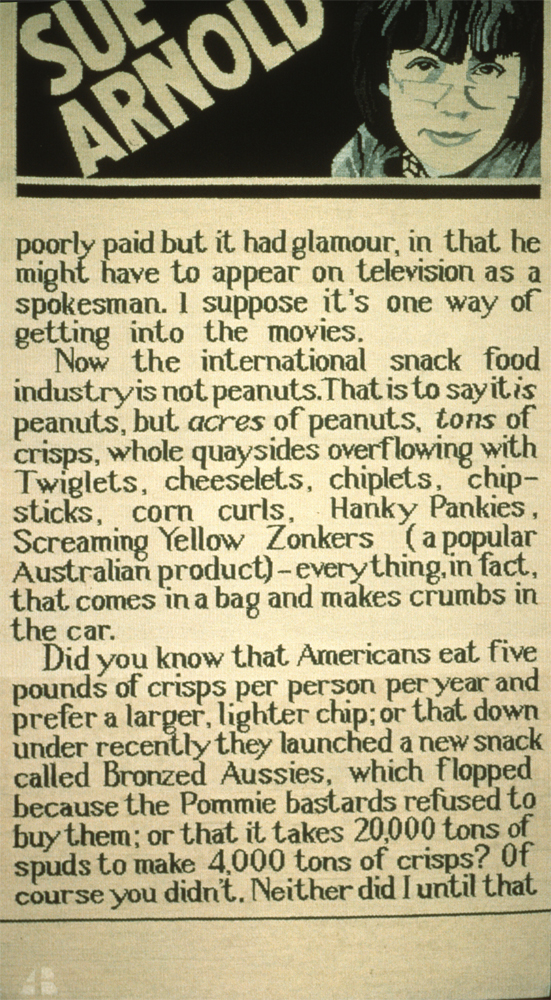
Archie Brennan’s tapestry Was It Worth It Mr. Gutenberg? seems to question (tongue in cheek) the application of movable type to such mundane issues as corn curls and cheeselets. The irony in questioning the worth of sixty seconds of arranging movable type which produced thousands, if not hundreds of thousands of copies of Sue Arnold’s thirty minute meditation on junk food, when Brennan spent, probably, 120 plus hours of weaving to produce one additional copy, is explicit. Of course, it is not the answer, as Duchamp taught us, but the question that is more important, and it is the question that few feel as comfortable to let stand as Brennan. Perhaps this fusion of two low culture forms (newspaper and tapestry) is the ultimate match. In his maniacal devotion and yet subversive questioning of the traditions of the medium, Brennan joins the artistic metanarrative that many artists chose to conduct through their work.
The use of text in textiles refers directly to the decorative legacy of weaving and can act as both commentary on the limits of the culturally inscribed boundaries of art and craft and as a way of celebrating the decorative potential of textiles. Text integrated into cloth reinforces both the medium and the message. It combines intellectual content with decorative aesthetics. In the many self referential tapestries that Brennan has woven, such as Slit , the image , the text and the tapestry become one. Their meaning and content is demonstrated simultaneously through visual, verbal and woven means. Humorously compelling, they laugh at our expectations of art at the same time that we laugh at their ingeniousness. In their absolute reduction to means, their equation of content and context, they are, perhaps, the rhetorical question that needs to be addressed to the tapestry community’s insistent concern with its own identity.
End Notes
- Owens, Craig, Beyond Recognition: Representation, Power and Culture (University of California Press: Berkeley, 1992). This collection includes essays on artists as well as theoretical writings. Many of them focus on the ways in which representation is used by a culture to build and maintain social structure and cultural ideology.
- Crary, Jonathan, Techniques of the Observer: On Vision and Modernity in the Nineteenth Century (MIT Press: Cambridge, 1990). Crary discusses the visual and the observer as historical products as as well as social factors that influence and are influenced by these two constructs.
- Arnheim, Rudolph, Visual Thinking (University of California Press: Berkeley, 1969) 245.
- Craig, Gerry, “Imagination and Sensation” (Fiberarts Nov/Dec 1995:53). Craig discusses the role of textile processes and structure in the development of human language.
- Bryson, Norman, Word and Image: French Painting of the Ancien Regime (Cambridge University Press: Cambridge, 1981) 3.
- Zrebiec, Alice, Introduction Tapestry: The Narrative Voice 1.
- Bryson, Norman, Vision and Painting: The Logic of the Gaze (University of Chicago Press: Chicago, 1994) 98 and 123. In discussing the changing ways in which images have reflected the world, Bryson offers an interesting explanation for how realism convinces the viewer that what s/he is seeing is a copy of reality by increasing the amount of detail in an image.
- Lawson, Thomas, “Last Exit: Painting,” Art After Modernism: Rethinking Representation, ed. Brian Wallis (The New Museum of Contemporary Art: New York, 1984) 154.
- Foster, Hal, “Re: Post” Art After Modernism: Rethinking Representation, ed. Brian Wallis (The New Museum of Contemporary Art: New York, 1984) 194.
- Owen, Craig, “The Allegorical Impulse: Toward a Theory of Postmodernism” Beyond Recognition: Representation, Power and Culture (University of California Press: Berkeley, 1992). This essay and its sequel, Part 2, connect postmodernism to many of the features of allegory, such as an interest in saving the past and the use of fragmentation and appropriation.
- Wallis, Brian, Introduction Art After Modernism: Rethinking Representation (The New Museum of Contemporary Art: New York, 1984). Wallis discusses the way in which much of postmodern writing and images concern themselves with he nature of representation and its function within culture.
- Mitchell, WJT, Picture Theory: Essays on the Verbal and Visual Representation (University of Chicago Press: Chicago, 1994), 82. Mitchell’s discussion of metapictures is especially clear in explaining how images can reflect upon the nature of image making itself.
